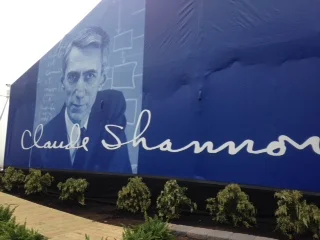Claude Shannon, "Father of Information Theory," Celebrated at Bell Labs
Two hundred and fifty information theorists, scientists, engineers and researchers from around the world converged at Nokia Bell Labs in Murray Hill last Thursday and Friday to celebrate the centennial of mathematician Claude Shannon (born April 30, 1916, in Petoskey, Michigan.) Shannon authored a sensational and game-changing 1948 paper, “A Mathematical Theory of Communication,” proposing that data from any kind of message—whether audio, video, or text—could be reduced to “bits” of information (“bit,” a contraction of “binary” and “digital,“ was attributed by Shannon to a colleague, John Tukey.) Shannon suggested that measurable bits of information could be captured “digitally,” and that data transmissions were governed by laws and principles related to the source, signal, capacity of the transmitter, and “noise” or interference during transmission. As author Jon Gertner wrote in The Idea Factory, "mathematicians would debate not whether Shannon was ahead of his contemporaries..., [but] whether he was twenty, or thirty, or fifty years ahead."
The Nokia Bell Labs conference entitled, "The Future of the Information Age", opened with a rich sequence of talks by Irwin Jacobs (who co-founded Qualcomm in 1985 with no financing, no business plan, and no product), Robert Metcalfe (inventor of Ethernet in 1973 and founder of 3Com Corporation, Eric Schmidt (Executive Chairman of Alphabet Inc., which encompasses Google Inc.), Amber Case (“cyborg anthropologist” and user experience designer), and Henry Markram (neuroscientist and founder of the Blue Brain Project focused on algorithmic "reconstruction and simulation of the brain on supercomputers").
Afternoon research demonstrations and a technology showcase highlighted topics such as augmented intelligence, robotic animation and collaboration, autonomous vehicles, “zero-touch clouds,” and the future digital fabric integrating “smart” cities with rural living.
A dazzling half-hour compression of Shannon's work by Vincent Poor, Dean of Princeton University's School of Engineering and Applied Science, and Michelle Effros, Professor of Electrical Engineering at California Institute of Technology on Friday dramatized his impact.
Using a tag-team approach, the pair recounted in 2-minute segments Shannon's astounding accomplishments in 9 areas of inquiry:
- Capacity
- Multi-user Channels
- Channel Coding
- Detection and Hypothesis Testing
- Source Coding
- Learning and Big Data
- Complexity and Combinatorics
- Cybersecurity
- Applications of information theory beyond the traditional communications realm.
Today, seven decades later, research in all of these areas can be traced directly to Claude Shannon's visionary insights developed amidst the interdisciplinary culture of Bell Labs.
Though aspects of the Conference pointed to a utopian future of humankind made ever-smarter and more effective by total information access and connectivity, anthropologist and tech designer Amber Case's talk on "Designing Calm Technology" offered a refreshingly contrarian view. She sees the oft-cited "50 billion devices online by 2020" as a nightmare scenario, and shudders at the incessant beeps and bleeps in the "Dystopian Kitchen of the Future" designed by techies who "haven't read history" and "have no idea how things really work."
Case regrets our current cacophony of interruptive tools. She argues that well-designed technology will demand just some of our attention, only when necessary, and that designers should focus on the task and desired results, rather than the gadgets themselves. "You shouldn't be a systems engineer to live in your own home," she claims.
Those of us concerned by the under-branding of humanities should be buoyed by Case's personal thoughts shared backstage after her talk. She was raised without TV (both parents were in broadcasting and wanted a break when at home), with World Book encyclopedia, Plato's dialogues, and Scott Joplin rags close at hand. When leaning toward attending MIT or Caltech, her Math professor implored her to "go to a liberal arts college where they teach you how to think." Case majored in Anthropology at Lewis and Clark College in Portland, Oregon, and is now a “user experience designer” working to optimize the interaction of humans, computers, creative culture, design, and our societal goals. Explore her ideas at CaseOrganic.com.
For a dive into the legacy of Claude Shannon and Bell Labs, including women tech pioneers and human computers, go to https://www.bell-labs.com/claude-shannon.




